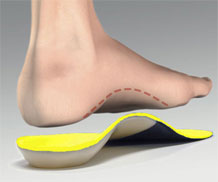Foot orthoses are a crucial part of the treatments used by specialists with patients suffering from the lower leg and foot pain. Podiatrists are highly qualified professionals recognized for providing high-quality care to the general public, but many people are not familiar with the specifics of the work they do or the nature and purpose of orthoses. But the general public is becoming more informed about this subject and general healthcare providers are offering more services regarding orthoses, so it’s important that podiatrists constantly update their knowledge and remain at the forefront of their field.
 There many types of foot orthoses, each with a different intended function and it’s important to be aware that there are many categories and subcategories for these devices. Essentially, a foot orthosis is a medical device that is placed in the shoe in order to influence, remediate and/or control the patterns and forces affecting the foot in order to reduce pathological and damaging load forces and to increase normal foot and lower leg function during weight-bearing activities.
There many types of foot orthoses, each with a different intended function and it’s important to be aware that there are many categories and subcategories for these devices. Essentially, a foot orthosis is a medical device that is placed in the shoe in order to influence, remediate and/or control the patterns and forces affecting the foot in order to reduce pathological and damaging load forces and to increase normal foot and lower leg function during weight-bearing activities.
In the broadest of terms, foot orthoses are divided into two main categories: non-prescription foot orthoses and prescription foot orthoses. Working definitions of both of these categories are provided below:
Non-prescription Foot Orthoses: This type of device is created using general shape and size measurements because they are designed to suit as many people as possible. They tend to be one-size-fits-all or rudimentarily adjustable. Three-dimensional models of the foot are not part of the design process.
Prescription Foot Orthoses: Custom orthoses are designed using a three dimensional model of a particular foot and are created for a specific individual using both their weight-bearing and non-weight-bearing measurement data. Information garnered from observing the foot and lower leg during weight-bearing activities is also used.
Depending on their intended purpose, Prescription foot orthoses can be divided into three main categories according to purpose: functional foot orthoses, accommodative foot orthoses, and functional/accommodative foot orthoses.
Functional foot orthoses are used to alter movement in the joints of the foot and lower leg during weight-bearing activities.
Accommodative foot orthoses are used to change the range of motion and the loading patterns in injured and/or inflamed plantar aspects of the foot during weight-bearing activities.
Functional/accommodative foot orthoses are used to alter the movement of the joints in the foot and lower leg and to change the range of motion and the loading patterns in injured and/or inflamed plantar aspects of the foot during weight-bearing activities.
The following definitions are accredited to professionals working in the field and/or other first-hand credible sources. They are not given in order of significance and they are titled according to their source(s).
Dorland’s Illustrated Medical Dictionary
The 25th edition of Dorland’s Illustrated Medical Dictionary provides us with the following definition of foot orthoses:
“An orthopedic appliance or apparatus used to support, align, prevent, or correct deformities or to improve the function of the movable parts of the body.”
This is a solid, medical definition of orthoses but it’s a little general; a better definition would specifically describe the role orthoses play in treating foot and lower leg pathologies.
Kent Wu
Kent Wu is an orthopedic surgeon who has written and lectured at length on the subject of the various treatments for foot disorders and their relative effectiveness. He defines orthoses this way:
“A foot ortheses is a medical device employed to support and align the foot, to prevent or correct foot deformities, or to improve the functions of the foot”
Wu, Kent K.: Foot Orthoses: Principles and Clinical Applications. Williams and Wilkins, Baltimore, 1990, p. 97.
This is a very functional definition of orthoses as it describes what its function is, though I do not agree that they can actually correct existing deformations of the foot. Also, an absolutely ideal definition would address the ways in which foot orthoses are believed to improve foot and lower limb functions, and how they can relieve common symptoms.
Ray Anthony
Ray Anthony is a podiatrist and owner of a laboratory in England that specializes in foot orthoses. His definition is the best that I’ve encountered in medical literature, and this was taken from a 1991 book that he had written on the subject:
“The functional orthosis is an orthopaedic device which is designed to promote structural integrity of the joints of the foot and lower limb, by resisting ground reaction forces that cause abnormal skeletal motion to occur during the stance phase of gait”
Anthony, Raymond J.: The Manufacture and Use of the Functional Foot Orthosis. Karger, Basel, Switzerland, 1991, p.5.
In fact, Ray Anthony is so adept at defining orthoses that a recent edition of a podiatric biomechanics reference book uses his definition of functional orthoses in a chapter reviewing the materials used to create said devices (Olson, William R., Orthotic Materials, in Valmassy, Ronald L. (ed), Clinical Biomechanics of the Lower Extremity, Mosby, St. Louis, 1996, p. 308).
Despite the fact that his definition includes a fairly involved and sophisticated outline of how foot orthoses work I still feel that it can be updated to more currently reflect the knowledge that we now have.
